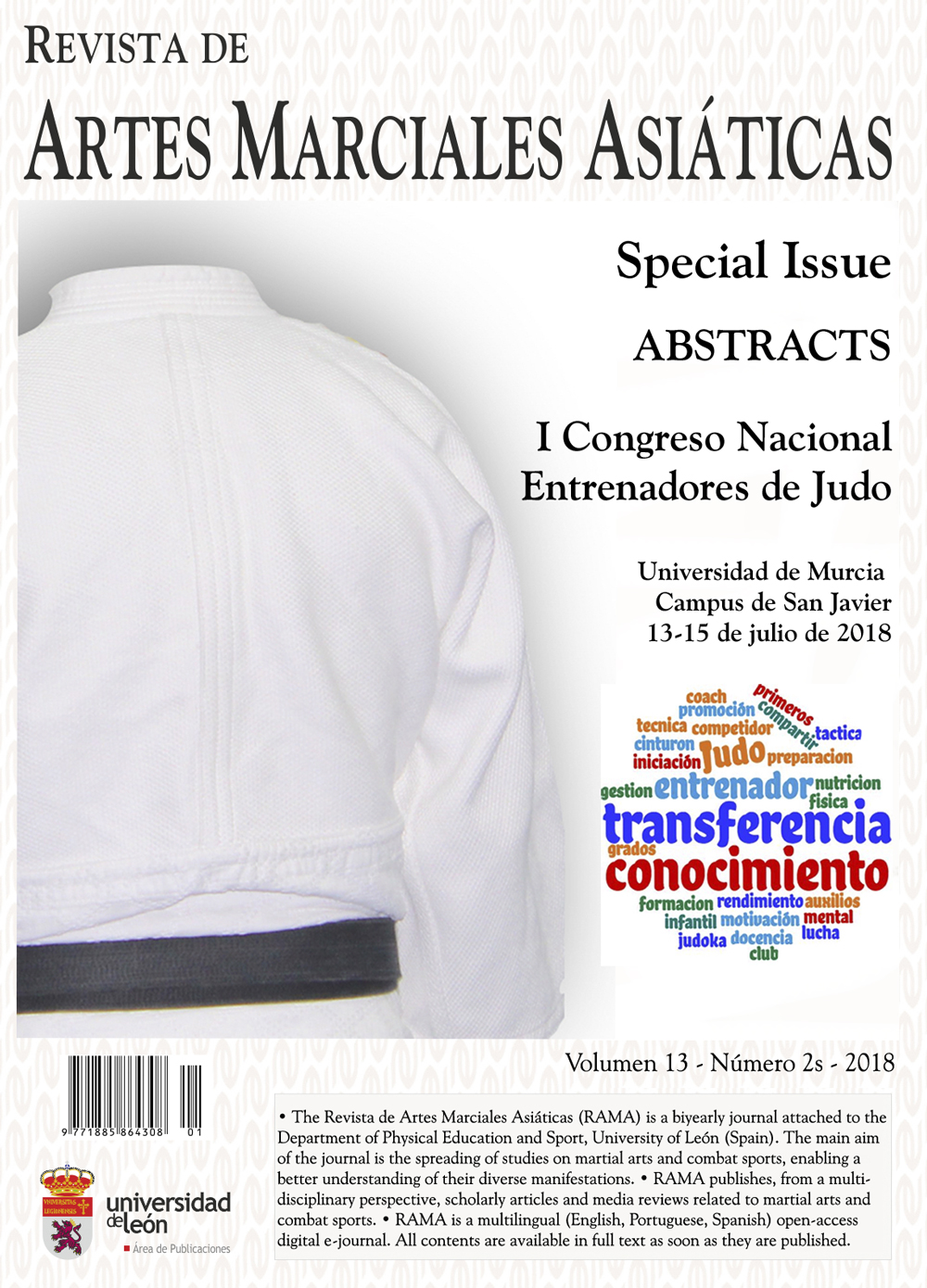Effect of age category on the flexibility profile in young taekwondo athletes
DOI:
https://doi.org/10.18002/rama.v13i2s.5504Keywords:
Combat sports, taekwondo, combat sport, range of movement, competitive level, performanceAbstract
The main aim of this study was to analyze the effect of the age category on the flexibility profile in young taekwondo athletes, by using angular tests. A total of 17 young taekwondo athletes were recruited, who were classified according to their federative age category. The range of motion of the main movements of the lower extremity was assessed by using the "ROM SPORT" protocol. A descriptive analysis was made of each of the quantitative variables, which included means and standard deviations. A t-test was used to determine the existence of differences between the dominant and non-dominant limbs. In addition, the same statistical test analyzed the interaction between the 11 selected movements and age categories. Finally, the effect size of the results was calculated. The results showed significant differences between cadets and juniors categories in EC (iliopsoas), RIC (external rotators), REC (internal rotators) and total rotation of the hip (sum of RIC and REC). These results are not in tune with other studies that have assessed flexibility in taekwondo. Cadet taekwondo athletes had higher values of flexibility than the junior category in the internal and external rotator muscles and in the psoas-iliac.
Downloads
Métricas alternativas
References
Bridge, C.A., Ferreira da Silva Santos, J., Chaabène, H., Pieter, W., & Franchini, E. (2014). Physical and physiological profiles of taekwondo athletes. Sports Medicine, 44(6), 713-33. doi: http://doi.org/10.1007/s40279-014-0159-9
Cardozo, L. A., Vera-Rivera, D. A., Conde-Cabezas, O. A. y Yánez, C. A. (2017). Aspectos fisiológicos de deportistas elite de taekwondo: Una revisión narrativa. Revista Española de Educación Física y Deportes, (418), 35-46.
Cejudo, A. (2015). Deporte y flexibilidad: Rendimiento deportivo sin riesgo de lesión (Tesis Doctoral). Universidad de Murcia, San Javier, España.
Cejudo, A., Sainz de Baranda, P., Ayala, F. & Santonja, F. (2015). Test-retest reliability of seven common clinical tests for assessing lower extremity muscle flexibility in futsal and handball players. Physical Therapy in Sport, 16(2), 107-113. doi: http://doi.org/10.1016/j.ptsp.2014.05.004
Cohen, J. W. (1988). Statistical power analysis for the behavioral sciences. Hillsdale, NJ: Lawrence Erlbaum Associates.
Heller, J., Peric, T., Dlouha, R., Kohlíková, E., Melichna, J., & Nováková, H. (1998). Physiological profiles of male and female taekwon-do (ITF) black belts. Journal of Sports Sciences, 16(3), 243-249. doi: http://doi.org/10.1080/026404198366768
Markovic, G., Misigoj-Durakovic, M., & Trninic, S. (2005). Fitness profile of elite Croatian female taekwondo athletes. Collegium antropologicum, 29(1), 93-9.
Pieter, W., & Heijmans, J. (2003). Training and competition in taekwondo. Journal of Asian Martial Arts, 12, 8-22.
Pieter, W. (1991). Performance characteristics of elite taekwondo athletes. Korean Journal of Sport Science, 3, 94-117.
Pion, J., Fransen, J., Lenoir, M., & Segers, V. (2014). The value of non-sport-specific characteristics for talent orientation in young male judo, karate and taekwondo athletes. Archives of Budo, 10, 147-150.
Suzana, M., & Pieter W. (2009). Motor ability profile of junior and senior taekwondo club athletes. Brazilian Journal of Biomotricity, 3(4), 325-331.
Wasik, J. (2009). Structure of movement of a turning technique used in the event of special techniques in Taekwon-do ITF. Archives of Budo, 5, 111-115.
World Taekwondo Federation. (2017). WTF website. Recuperado de www.worldtaekwondo.org
Downloads
Published
How to Cite
Issue
Section
License
Copyright (c) 2018 Antonio Cejudo Palomo, Blanca San Cirilo Soriano, Francisco Javier Robles Palazón, María Del Pilar Saiz De Baranda

This work is licensed under a Creative Commons Attribution-NonCommercial-ShareAlike 4.0 International License.
The authors who publish in this journal must agree to the following terms:
- The authors grant on a nonexclusive basis the exploitation rights (reproduction, distribution, public communication and transformation) of the work accepted for publication to the University of León. The authors can establish, on their own, additional agreements for the non-exclusive distribution of the version of the work published in the journal (for example, placing it in an institutional repository or publishing it in a book), always acknowledging the initial publication in this journal.
- This work is licensed under the Creative Commons Attribution-NonCommercial-ShareAlike 4.0 International License. Click to see basic information and the legal text of the license.
- The authors are allowed and encouraged to disseminate electronically pre-print or post-print versions of their work before publication, as this can give rise to productive exchanges, as well as earlier and increased citing of the works published.











